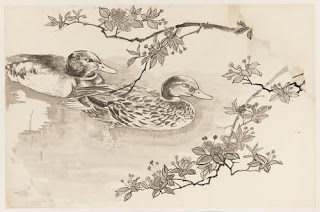Xie Zhiliu (1910-1997) at the Met
The title of the exhibition says it all: Mastering the Art of Chinese Painting. Unlike many Chinese artists, Xie Zhiliu, a native of Changzhou, kept the copies and sketches he made throughout his career, and these now provide an absorbing account of the development of a traditional Chinese painter working in the twentieth century.
Copying the masters and working from nature were the complementary disciplines of such an education. Not knowing the tradition in which he worked, I found it hard to distinguish between Xie's work and the work of his chosen masters, like the Ming painter Chen Hongshu (1599-1652) and other bird-and-flower painters. I could see that his lines, as a young painter in his twenties, were less sure than theirs, but I could not see how he departed from them deliberately. Even the drawings done from nature looked as if they had been traced.
I was most impressed by the work in the last gallery. (I could not find any images of the work on the Met website.) The years of imitation and study paid off in an original freedom. In 1994, Xie made a brightly colored album called Views of Yosemite National Park, California, after visiting the reserve with his wife. The mountains were rendered with Chinese feeling for both mass and etherealness. Xie remarked that the pine trees in the park made up half of the beauty of the place, a sentiment that is observable in so many Chinese landscape paintings. Leaves 8 and 10 of the album were particularly beautiful for their abstraction and color.
Even more interesting, to me, was the eight-leaf study of a lotus pond. In leaf after leaf, the lotus flower contended with the swirling wash of ink until it emerged from the darkness, in full bloom. Other lotus stalks, barely glimpsed earlier but now seen in the white space, reinforced the victory of the verticals.
Copying the masters and working from nature were the complementary disciplines of such an education. Not knowing the tradition in which he worked, I found it hard to distinguish between Xie's work and the work of his chosen masters, like the Ming painter Chen Hongshu (1599-1652) and other bird-and-flower painters. I could see that his lines, as a young painter in his twenties, were less sure than theirs, but I could not see how he departed from them deliberately. Even the drawings done from nature looked as if they had been traced.
I was most impressed by the work in the last gallery. (I could not find any images of the work on the Met website.) The years of imitation and study paid off in an original freedom. In 1994, Xie made a brightly colored album called Views of Yosemite National Park, California, after visiting the reserve with his wife. The mountains were rendered with Chinese feeling for both mass and etherealness. Xie remarked that the pine trees in the park made up half of the beauty of the place, a sentiment that is observable in so many Chinese landscape paintings. Leaves 8 and 10 of the album were particularly beautiful for their abstraction and color.
Even more interesting, to me, was the eight-leaf study of a lotus pond. In leaf after leaf, the lotus flower contended with the swirling wash of ink until it emerged from the darkness, in full bloom. Other lotus stalks, barely glimpsed earlier but now seen in the white space, reinforced the victory of the verticals.


Comments